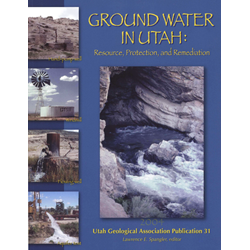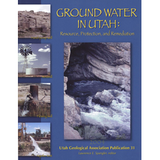Ground water in Utah: Resource protection and remediation (UGA-31)
Edited by: L. E. Spangler
Ground water in Utah is an important and current subject. Ground water as a resource is under increased pressure because of droughts, and because of continuing development in many parts of the state. Several artificial recharge projects are in place or being investigated. Projection of ground water is vital as more people live and work in areas that affect the aquifers. Ground-water remediation work is important because human activities have adversely impacted ground water in Utah.
The papers in this guidebook cover many aspects of ground water in different parts of the state. These papers demonstrate how scientists are increasing our knowledge of aquifer systems and how we are learning more about developing, protecting, and remediating these aquifers. The papers found in this publication are listed below:
Development of concepts of regional ground-water flow in the part of the Great basin in eastern Nevada and adjacent California and western Utah - a review, by J. S. Gates
The role of geology in increasing Utah’s ground-water resources form faulted terranes - lessons from the Navajo Sandstone, Utah, and the Death Valley flow system, Nevada-California, by P. D. Rowley and G. L. Dixon
Updated conceptual and MODFLOW ground-water models of Cache Valley, Utah and Idaho, by T. E. Lachmar, B. Myers, and J. M. Robinson
Isotopic characterization of ground water in Salt Lake and Cache Valleys, Utah, by T. E. Lachmar, J. W. Gadt, and J. M. Robinson
Source of ground water to Locomotive Springs, southeastern Curlew Valley, Box Elder County, Utah, by R. Q. Oaks, Jr.
Permeability distribution within a fine-grained lacustrine delta, Late Pleistocene Lake Bonneville, northern Utah, by D. R. Lemons and M. A. Chan
Ground-water development in Utah and effects on ground-water levels and chemical quality, by J. S. Gates
Sources of groundwater used for public supply in Salt Lake Valley, Utah, and relation to water quality, by S. A. Thiros and A. H. Manning
Hydrogeology of Government Creek Basin, Dugway, Utah, with a recommended practical approach to ground-water management in arid, saline regions of the Great Basin, by J. Fitzmayer, D. Larsen, D. Braxton, and E. Staes
Unraveling uncertainties in delineating ground-water protection areas in fractured rocks: case studies in the Navajo Sandstone and Twin Creek Limestone, Grand and Summit counties, Utah, by V. Kin, T. Jarvis, and S. Willsey
Ground-water protection issues in Cedar Valley, Iron County, Utah, by S. A. Finstick
The ground-water reservoir as long-term carryover storage: Cedar Valley, Iron county, Utah, by B. Everitt
The chloride mass-balance approach for estimating recharge from precipitation in Cedar Valley, an alluvial basin in Iron County, southwestern Utah, by J. L. Mason
Water budget estimates for the Powder Mountain region, Cache and Weber counties, Utah: methods and proper use of ground-water recharge estimations, by V. F. King
Results of tracer investigations in the Empire Canyon Area, Park City, Utah, by A. Tillia
Other Information:
Published: 2005
Pages: 261 p.
Location: Beaver County, Box Elder County, Cache County, Davis County, Grand County, Iron County, Juab County, Millard County, Morgan County, Salt Lake County, Sanpete County, Sevier County, Summit County, Tooele County, Utah County, and Washington County
Media Type: Paper Publication







